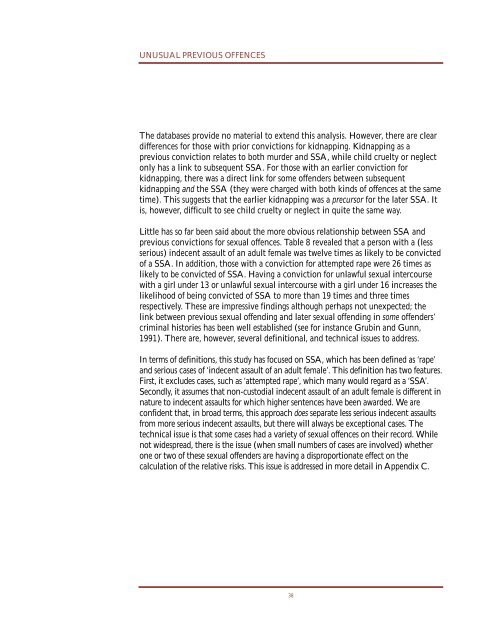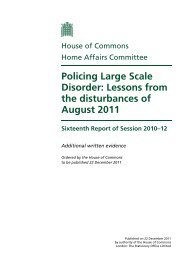Murder and Serious Sexual Assault - Lancaster EPrints - Lancaster ...
Murder and Serious Sexual Assault - Lancaster EPrints - Lancaster ...
Murder and Serious Sexual Assault - Lancaster EPrints - Lancaster ...
Create successful ePaper yourself
Turn your PDF publications into a flip-book with our unique Google optimized e-Paper software.
UNUSUAL PREVIOUS OFFENCES<br />
The databases provide no material to extend this analysis. However, there are clear<br />
differences for those with prior convictions for kidnapping. Kidnapping as a<br />
previous conviction relates to both murder <strong>and</strong> SSA, while child cruelty or neglect<br />
only has a link to subsequent SSA. For those with an earlier conviction for<br />
kidnapping, there was a direct link for some offenders between subsequent<br />
kidnapping <strong>and</strong> the SSA (they were charged with both kinds of offences at the same<br />
time). This suggests that the earlier kidnapping was a precursor for the later SSA. It<br />
is, however, difficult to see child cruelty or neglect in quite the same way.<br />
Little has so far been said about the more obvious relationship between SSA <strong>and</strong><br />
previous convictions for sexual offences. Table 8 revealed that a person with a (less<br />
serious) indecent assault of an adult female was twelve times as likely to be convicted<br />
of a SSA. In addition, those with a conviction for attempted rape were 26 times as<br />
likely to be convicted of SSA. Having a conviction for unlawful sexual intercourse<br />
with a girl under 13 or unlawful sexual intercourse with a girl under 16 increases the<br />
likelihood of being convicted of SSA to more than 19 times <strong>and</strong> three times<br />
respectively. These are impressive findings although perhaps not unexpected; the<br />
link between previous sexual offending <strong>and</strong> later sexual offending in some offenders’<br />
criminal histories has been well established (see for instance Grubin <strong>and</strong> Gunn,<br />
1991). There are, however, several definitional, <strong>and</strong> technical issues to address.<br />
In terms of definitions, this study has focused on SSA, which has been defined as ‘rape’<br />
<strong>and</strong> serious cases of ‘indecent assault of an adult female’. This definition has two features.<br />
First, it excludes cases, such as ‘attempted rape’, which many would regard as a ‘SSA’.<br />
Secondly, it assumes that non-custodial indecent assault of an adult female is different in<br />
nature to indecent assaults for which higher sentences have been awarded. We are<br />
confident that, in broad terms, this approach does separate less serious indecent assaults<br />
from more serious indecent assaults, but there will always be exceptional cases. The<br />
technical issue is that some cases had a variety of sexual offences on their record. While<br />
not widespread, there is the issue (when small numbers of cases are involved) whether<br />
one or two of these sexual offenders are having a disproportionate effect on the<br />
calculation of the relative risks. This issue is addressed in more detail in Appendix C.<br />
38
















